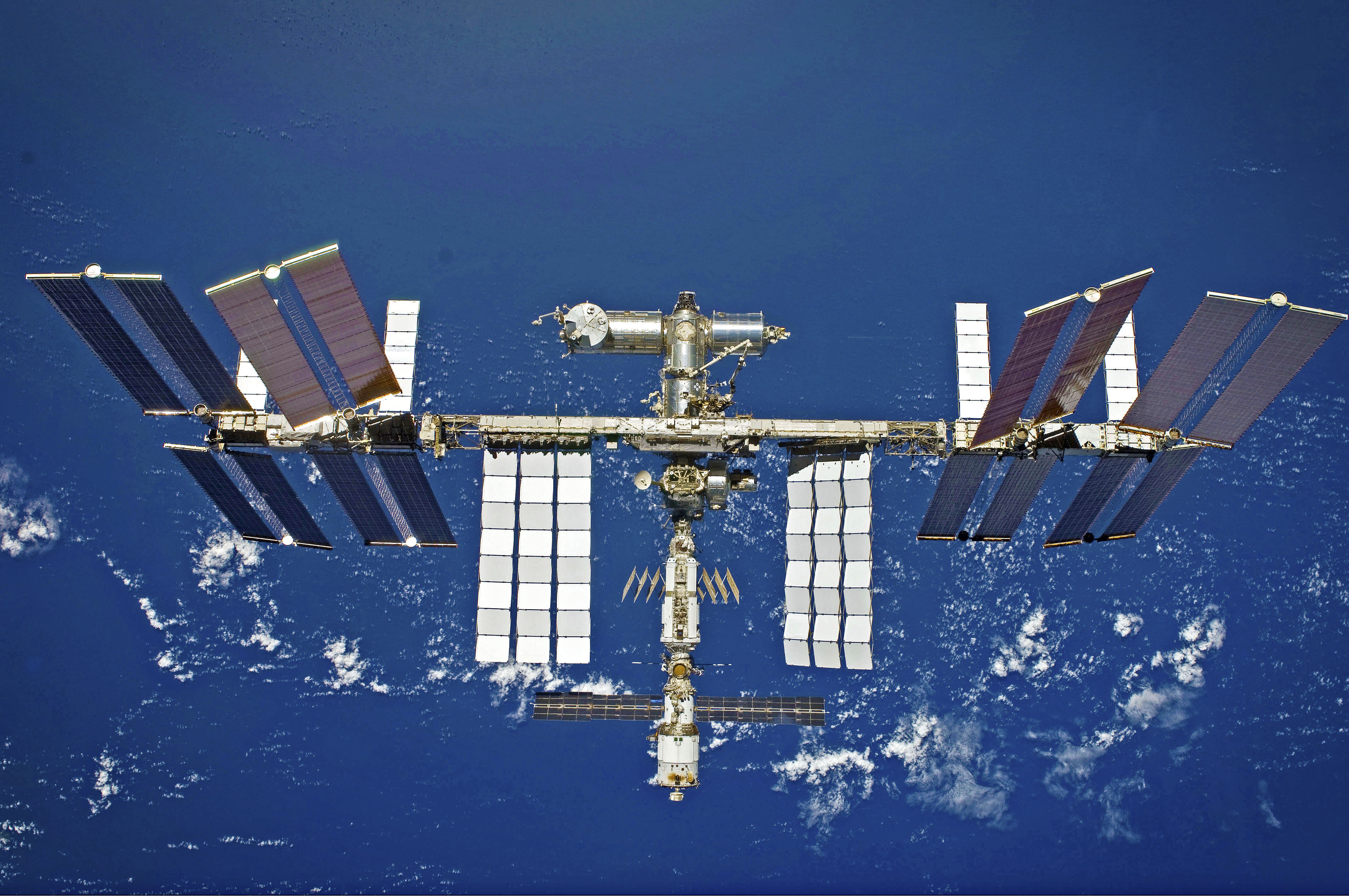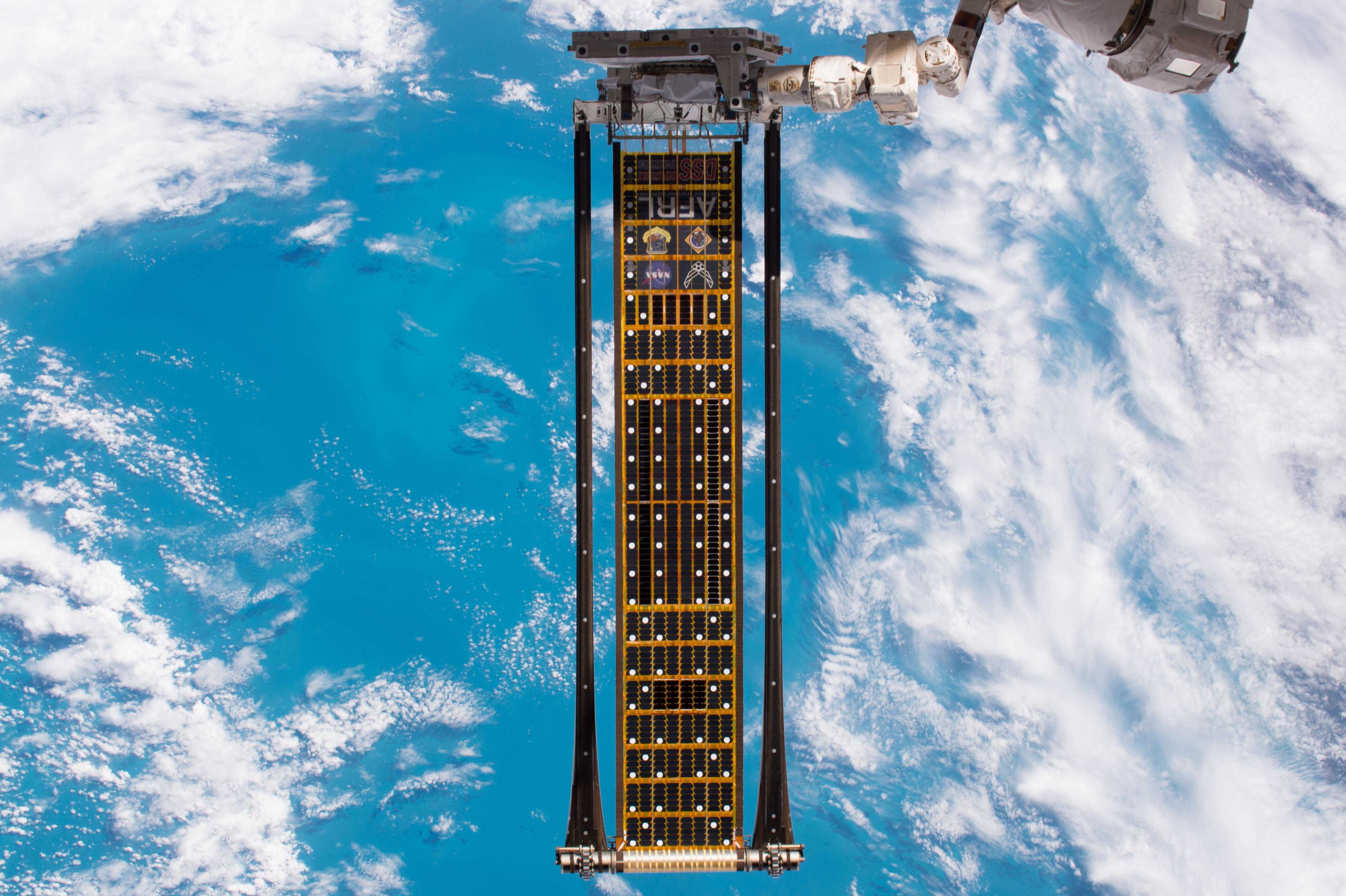
International Space Station in 2009. The new solar arrays will be placed over the left-most arrays in this picture.
The setup for both spacewalks is similar, Shane and Thomas will prepare in the morning, exit the Quest Airlock at 14:00 CEST (12:00 GMT) to retrieve a set of rolled up solar arrays, move them to the left-most solar wings of the Space Station on this photo and deploy the tubes that will unfurl automatically, connect the arrays, clean up and head back inside.
Update for second spacewalk on Sunday: Before the first array can be deployed and begin providing power to the Space Station, Shane and Thomas will install electrical cables and drive the final two bolts so the first solar array can unfurl into position. The duo will then start work on installing the second solar array.
Watch both spacewalks live on ESA’s Web TV that is transmitting the NASA feed from 12:30 CEST (10:30 GMT) on both days.
Of course it is much more complicated than that. Let’s look at their day outside in detail.
The morning starts early getting into the spacesuit, which is a task in itself. Due to the oxygen-rich environment in the spacesuit no shaving or other products can be used by the spacewalkers. NASA astronaut Mark Vande Hei is the main aid to help Shane and Thomas into their suits. Thomas will be EV1 and wear a suit with red stripes, Shane – no stripes – is EV2. NASA astronaut Megan McArthur will help too, but her main role during the spacewalk is to operate the robotic arm that will move Thomas into position, later on in the day.
The team already tested the spacesuits last week to ensure radio communications work and everything fits. The spacesuits operate at low air pressure so the difference between the vacuum of space and the spacesuit is as small as possible, while still being safe for the astronauts. The less pressure difference the more the suits are easy to move in. As the air pressure in the suit is lower than the air pressure in the Space Station Shane and Thomas need to prepare their bodies to avoid “the bends”. Nitrogen in our bodies can form bubbles as pressure decreases with serious health effects. Scuba divers and spacewalkers can avoid this by purging nitrogen from their bodies by breathing pure oxygen. Doing mild exercise increases the purging and Shane and Thomas will do some hand-cycling as Mark and Megan prepare their suits.
Heading outside

Test unfurlable solar arrays used to demonstrate the technology in 2017. Credits: NASA
Once all is setup, the duo will be moved into the Quest airlock and Mark will close the hatch and test for air tightness. If all is well the outer hatch will open and Thomas will be the first to step outside.
Throughout the delicate process detailed below the duo will constantly attach and reattach themselves, their tools and the solar arrays to avoid anything floating away – including themselves. Working like mountain climbers, they will place safety tethers and ensure they are connected to something at all times.
Thomas will head to the new solar arrays that were moved by robotic arm from the SpaceX Cargo Dragon to the farthest place it can reach. As Thomas moves he will place safety anchors, like a mountain climber. Shane will follow and meet up with Thomas at the site where the solar arrays are waiting – rolled up into tubes and doubled up on themselves. The duo will drop off bags and tools needed to remove the solar array. Shane leaves Thomas and heads to the installation site placing foot restraints at strategic locations for when they pass the solar arrays to their installation site.
Thomas will start preparing the solar arrays for removal, by releasing bolts put in for launch, and installing handling aids so the astronauts can hold onto the solar arrays without damaging them, these are called “scoops”.
At the installation site Shane will be preparing more scoops and getting the cables ready for installation after the array has been unfurled. Once finished Shane will return to Thomas, where the arrays should be almost ready for moving.
Pass the parcel
Thomas will get a foot restraint and install it on the end of the 16-m long robotic arm. He will then strap himself into the restraint and with Megan at the controls from inside the Space Station, Thomas will move into position at the solar arrays. Two more bolts are released by Thomas, and then Shane does the last turns to allow Thomas to slide out the arrays and Megan will move the arm, with Thomas and the arrays out of their carrier, to the installation site.
Shane will move on his own to a halfway point, as far as the robotic arm can fly, where Thomas will hand over the long arrays to Shane. Shane takes over holding the arrays while Thomas returns by arm to a drop-off point, and returns to Shane. Thomas will then physically rotate Shane holding the arrays so they are in a position for installation.
At the installation site Thomas will then take over the arrays and wait for Shane to arrive. One of the scoops is removed, and the array is aligned and put into position. The second handling aid is removed and the tubes are extended and the arrays are ready for unfurling.
Thomas moves into position to drive out the last pins that separate the two tubes in the array by hand. Thomas and Shane then drive four bolts each to fix the array to the Space Station. The duo will then hook up the cables during night-time for extra safety, and the last bolts are removed to have the array unfurl automatically.

The new solar arrays unfurled on ground showing the large scale. Thomas and Shane will be working with arrays rolled into the two yellow tubes on the right of this picture. Initially they will be folded onto each other. Credits: Deployable Space Systems
Unfurling and clean-up
Unrolling will take around six minutes with the astronauts filming from both sides to monitor the process. The duo will then clear up their worksite and prepare for the second spacewalk by moving foot restraints into position.
The duo return to the airlock bringing one foot restraint with them for inspection. After the hatch is closed and tested for air-tightness. The airlock is repressurised and opened where Megan and Mark will be waiting to help Shane and Thomas out of their suits.

Artists’s impression of the complete set of new solar arrays placed over the existing ones. Thomas and Shane will be working on the right-most area in this image. Credits: Boeing
Sunday walk
The second spacewalk on Sunday is very similar but could go faster as Shane and Thomas will have had experience, and prepared the worksites at the end of the first spacewalk. In case they finish earlier, mission control has a load of extra tasks that they can do with their time. The investment put into a spacewalk to go outside is major and as much time is used as possible to get ahead with tasks planned for future spacewalks.
Timeline
All times are estimates, on the days itself Shane and Thomas might get through their tasks quicker or slower than expected.
| CEST | GMT | |
| 12:30 | 10:30 | Live transmission starts |
| 14:00 | 12:00 | Leave airlock |
| 14:30 | 12:30 | Prepare worksite and solar arrays for removal |
| 16:00 | 14:00 | Release solar arrays |
| 16:30 | 14:30 | Install solar arrays |
| 17:30 | 15:30 | Connect cables during night-time |
| 18:00 | 16:00 | Deploy solar arrays |
| 18:30 | 16:30 | Cleanup |
| 19:00 | 17:00 | Extra tasks if time allows |
| 20:00 | 18:00 | Return to airlock |




